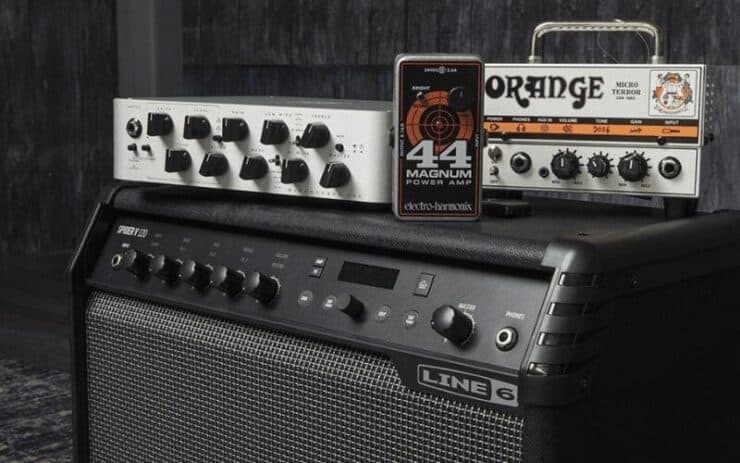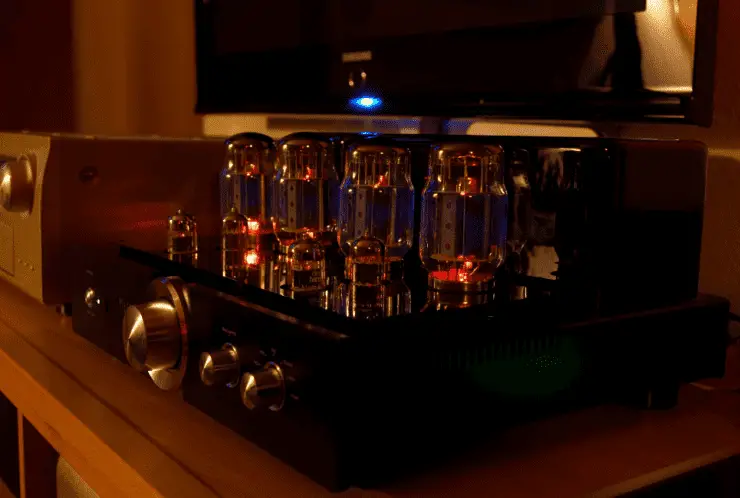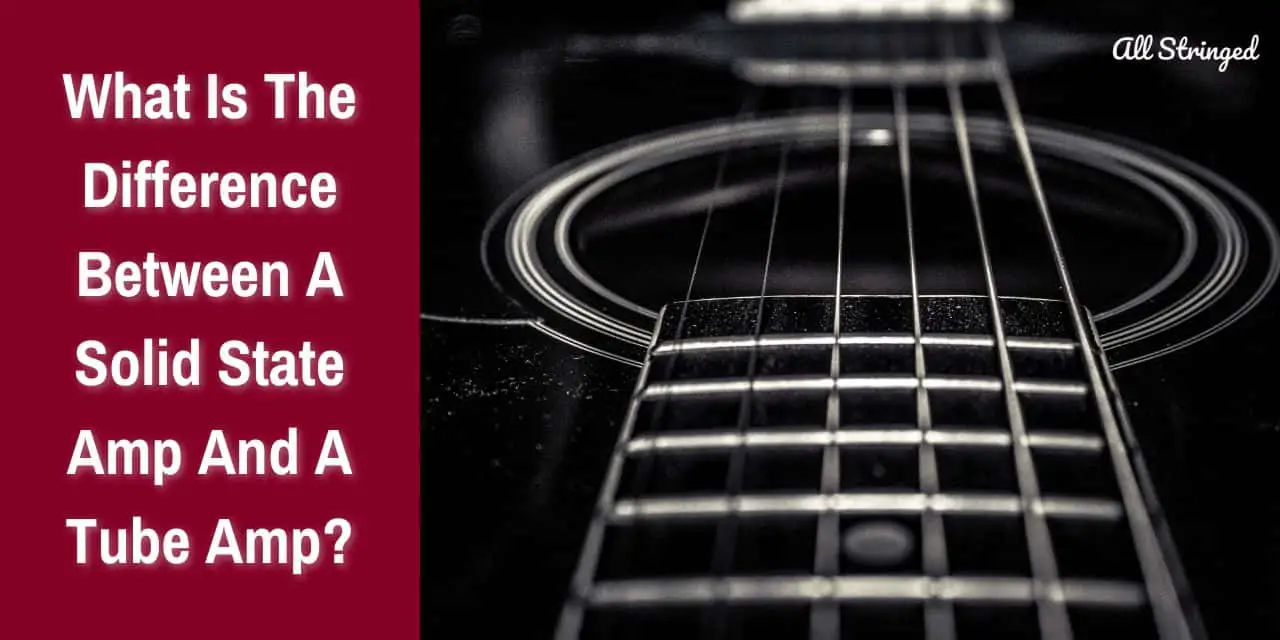Guitar players, have you ever wondered what the difference is between a solid state amp and a tube amp? If the answer is yes, then you’ve come to the right place. In this article, we’ll be exploring the differences between these two types of guitar amps, so you can make an informed decision when it comes to choosing the right amp for your music. Ready to get started? Read on!
Definition of a solid-state amp
Solid-state amps or also known as transistor amps are electronic devices that use semiconductor materials for amplifying electrical signals. These amps have become increasingly popular in recent decades thanks to their efficiency, high reliability, and compact size. Solid-state amps are designed using various types of semiconductor devices, including transistors, integrated circuits, and diodes. The most common types of transistors used in solid-state amps are bipolar junction transistors (BJTs) and field-effect transistors (FETs).
Here are the primary characteristics of a solid-state amp –
#1. Efficiency
One of the primary characteristics of solid-state amps is their high efficiency. Unlike vacuum tube amps, which consume a significant amount of power even when idle, solid-state amps consume little power when not in use. This makes them perfect for use in battery-powered devices, such as portable audio players.
>>> Click here to read our review about the Top 15 Best Tube Amps <<<
#2. Compact size
Due to the use of semiconductor materials, solid-state amps can be designed to be smaller than vacuum tube amps. This makes them perfect for use in portable devices, such as smartphones and tablets, where space is rather limited.
#3. High reliability
Solid-state amps offer high reliability. Unlike vacuum tube amps, which are prone to failure because of the use of fragile glass envelopes, solid-state amps are more durable and less prone to failure.
#4. Linearity
Solid-state amps are designed to be highly linear, which makes them perfect for use in high-fidelity audio systems. Linearity refers to the ability of an amp to faithfully reproduce the input signal without distorting it. Solid-state amps are designed to be highly linear, meaning that they can reproduce the input signal with a high degree of accuracy.
#5. Gain
Solid-state amps offer high gain, which allows them to easily amplify weak signals to a level that is suitable for driving speakers or other devices. The high gain will be important for amplifying the signal without introducing significant noise or distortion.
#6. Frequency response
Solid-state amps offer a wide frequency response, which means that they’re able to amplify signals across a wide range of frequencies. This makes them perfect for use in audio systems, where they can reproduce high and low frequencies with equal accuracy.
#7. Low noise
Solid-state amps produce little noise, which means that they can amplify signals without adding significant noise to the output signal. This is essential for maintaining high-fidelity sound reproduction.

Definition of a tube amp
Tube amplifiers or also known as valve amplifiers are electronic devices that make use of vacuum tubes for amplifying electrical signals. These amps have a long and rich history, and they’ve been used in a wide range of applications, including radio broadcasting, audio systems, and guitar amps.
The vacuum tubes used by tube amps are glass or metal containers that contain a vacuum. Inside the filament, electrons will be emitted when it gets heated. Meanwhile, there will be a plate that collects the electrons and amplifies the signal. The most common types of tubes used in tube amps are triodes, pentodes, and tetrodes.
Here are the primary characteristics of a solid-state amp –
#1. Warm and rich sound
One of the most significant characteristics of tube amps is their ability to produce a warm, rich sound. This is because of the way tubes amplify signals, which produces harmonic distortion and a pleasant sound. These amps are known for their ability to create a natural and musical sound that is highly sound after by audiophiles and musicians.
#2. Harmonic distortion
Harmonic distortion is a type of distortion produced by tube amps. It adds character and warmth to the sound, which is valued highly by musicians and audiophiles. Unlike solid-state amps, which are designed to be efficient and highly linear, tube amps are designed to produce a wide range of sounds and effects.
#3. Non-linearity
Another essential characteristic of tube amps is their non-linearity. Non-linearity refers to the way tube amps produce harmonic distortion and other types of distortion that add warmth and character to the sound. Non-linearity is valued highly by musicians and audiophiles, who often prefer the sound of tube amps over solid-state amps.
#4. High voltage and current handling
Tube amps are designed for handling high voltages and currents, which makes them perfect for use in high-powered audio systems and guitar amps. Unlike solid-state amps, which can be damaged by high voltages and currents, tube amps are designed to handle these high levels of power with ease.
#5. Customization
Tube amps offer a high degree of customization. Tube amps are designed to produce a wide range of sounds and effects. This makes them perfect for customization, as musicians and guitarists will have the freedom to experiment and customize. Further, it is also ideal for use in guitar amps, where musicians often like to create unique and personalized sounds.
#6. Visual appeal
Tube amps offer a unique visual appeal. The glowing tubes inside the amp create a warm and inviting glow that is highly desirable for many people. This visual appeal is often an important factor in the choice of tube amps, particularly for people who are passionate about vintage audio equipment.

What is the difference between a solid-state amp and a tube amp?
Whether you are a musician or a guitarist, you’ll be aware that the right amp can make all the difference when it comes to sound. The decision between a solid-state amp and a tube amp is not one that you should take lightly. Whether you’re new to the world of amps or upgrading your guitar amp, you will have to know the differences between solid-state and tube amps.
Both solid-state amps and tube amps come with their own unique characteristics and sound quality. As a result of these things, each type of amp has its own dedicated fan base. When you have to choose between solid-state and tube amps, there are various key factors you will need to consider. Some of the most significant differences between solid-state and tube amps include tone, power, maintenance, and more. Here is a closer look at the differences between a solid-state amp and a tube amp –
#1. Tone
One of the most significant differences between solid-state amps and tube amps is the way they affect tone. Solid-state amps are known for producing a clean, precise sound that is generally considered to be more accurate in comparison to the sound produced by tube amps. This is because solid-state amps are designed to be highly linear, with limited harmonic distortion. This makes them perfect for applications where precision and accuracy are critical, such as in studio recording.
Tube amps, on the other hand, are known best for producing a highly desirable warm, rich sound to many musicians and audiophiles. This is because the vacuum tubes in tube amps produce harmonic distortion and other non-linear effects that add character and depth to the sound. This makes them perfect for applications where tone and musicality are critical, such as during live performances and recording.
#2. Power
Another key difference between solid-stat amps and tube amps is their power output. Solid-state amps are typically more powerful than tube amps and can produce higher wattage outputs without distortion. This makes them perfect for applications where high-volume levels are needed, such as in concert venues.
Tube amps, on the other hand, are typically lower in power output than solid-state amps. However, they are often preferred by guitarists and audiophiles due to the unique way they handle power. Tube amps produce a more natural, musical sound at lower volume levels, which makes them ideal for applications where tone and musicality are more important than raw power.
#3. Maintenance
There are also significant differences in the extent of maintenance needed for solid-state and tube amps. Solid-state amps are generally considered to be more reliable than tube amps, with fewer components that can fail over time. They also need less maintenance as there are no tubes that have to be replaced periodically.
Tube amps, on the other hand, need more maintenance compared to solid-state amps. The vacuum tubes used in tube amps wear out over time and have to be replaced periodically. Moreover, tube amps need more careful handling, as fragile glass tubes can be damaged easily if mishandled.
#4. Technology
The most significant difference between solid-state amps and tube amps is the technology used for amplifying the sound. Solid-state amps use electronic circuitry made up of transistors and diodes for amplifying the guitar signal. Tube amps, on the other hand, make use of vacuum tubes or valves for amplifying the sound.
#5. Price
Solid-state amps are typically less expensive compared to tube amps, as they use less expensive electronic components. They are the more affordable option for beginners or musicians on a budget. Meanwhile, tube amps tend to be more expensive because of the use of vacuum tubes and other high-quality components.
Pros and cons of using solid-state amps
Pros
Solid-state amps have become quite popular in recent years as they offer numerous advantages over other types of guitar amps. Here are some of the biggest pros of using solid-state amps –
#1. Durability and reliability
Solid-state amps are known best for their rugged construction and durability. They are built using high-quality electronic components capable of withstanding a lot of wear and tear. This makes them ideal for gigging and touring musicians. Solid-state amps are less prone to breaking down or needing requires than tube amps, which is why they’re a reliable choice for musicians who require a dependable amp.
#2. Affordability for beginners
One of the biggest advantages of solid-state amps is their affordability. They make use of less expensive electronic components compared to other types of amps, such as tube amps. This makes them a much more accessible option for beginner musicians or guitarists on a budget. They are a great way of getting started with guitar amplification without breaking the bank.
#3. Produce a consistent tone
Solid-state amps are known for producing a consistent tone, which is perfect for music genres that need precision and accuracy, such as jazz and country. They do not have the subtle harmonic distortions that tube amps can produce. This is why they are a particular favorite for musicians who want a clean and clear sound.
#4. High power and efficiency
Solid-state amps are known best for their high power and efficiency. They can produce a lot of volume and are ideal for large venues and gigs where a lot of volume is needed. These amps are also quite efficient, which means that they use less power than other types of amps. This is why they’re a great choice for musicians who want a powerful amp without having to worry about their energy bill.
#5. Lightweight
Solid-state amps are comparatively lighter in weight compared to other amps. These amps use less bulky components, which makes them very easy to transport and set up. This is especially useful for musicians who travel frequently or have to move their equipment around a lot.

Cons
Although solid-state amps have many positives, it doesn’t mean they don’t have any negatives. There are certain disadvantages that must be considered before you make the purchase. Here are some of the cons of solid-state amps –
#1. Lack of warmth and richness of tone
Although solid-state amps are capable of producing a consistent tone, they do lack the warmth and richness of tube amps. They do not have the subtle harmonic distortions that give tube amps their unique sound, which might be a drawback for musicians who prefer a more organic tone.
#2. Don’t respond to changes
Solid-state amps do not respond well to changes in playing dynamics the same way that tube amps do. This means that the tone does not change as much when the player adjusts their playing style, which can sometimes result in a less expensive sound.
#3. Transient response
Solid-state amps offer a slower transient response than tube amps. Transient response refers to how quickly the amp responds to changes in the guitar signal, such as strumming or fast picking. This can result in a less immediate and punchy sound.
#4. Regular maintenance needed
While solid-state amps require less maintenance than tube amps, they will still have to be maintained and serviced regularly. The electronic components could wear out over time and have to be replaced, and the amp might have to be cleaned or repaired if it gets damaged.
#5. Overdrive
Solid-state amps can produce a harsh or brittle overdrive sound, especially at higher volume levels. This can be a drawback for guitarists and musicians who want a smooth and natural overdrive sound. Tube amps can achieve this more easily.
Pros and cons of tube amps
Pros
Tube amps seem to have become a staple in the music industry for the last few decades, and for good reason. They offer a unique sound and many advantages over other types of guitar amps. Here are some of the major pros of tube amps –
#1. Sound that cannot be replicated by others
One of the most notable pros of tube amps is their warmth and rich tone. Tube amps produce a natural and organic sound that is difficult to replicate with other types of amps. The tubes in the amp create subtle harmonic distortions, which add depth and dimension to the tone. Further, these also give the sound a unique character that many musicians prefer.
#2. Unmatched dynamic response
Tube amps offer a dynamic response that is unmatched by other types of guitar amps. They respond to changes in playing dynamics in a natural way, producing a wide range of tones from clean to overdriven with the touch of the guitarist’s fingers. This makes them perfect for expressive playing styles such as rock and blues.
#3. Natural and smooth overdrive
Tube amps are capable of producing a natural and smooth overdrive sound that is highly sound after by many musicians and guitarists. The overdrive is produced by pushing the tubes to their limits, which results in a natural and dynamic sound that cannot be replicated by other types of amps. This is why tube amps are generally used for genres such as blues and rock, where a smooth and natural overdrive is essential.
#4. Easy to maintain and repair
While tube amps require a fair bit of maintenance, they are generally easy to maintain and repair. Tube replacements and other repairs can be carried out by a qualified technician, which makes them a long-lasting investment for serious musicians.
#5. Versatility
Tube amps are quite versatile and can be used for a wide range of music genres. These amps are well-suited for classic rock, jazz, and blues, but they can also be used for any genre where warmth and depth of tone are needed.
Cons
Tube amps come with a wide range of positives but like any other electronic device, they are not perfect either. Even tube amps have a few negatives that must be considered. Here are some of the disadvantages that you must keep in mind before making the purchase –
#1. Pricier than other types of amps
Typically, tube amps happen to be more expensive than solid-state amps. This is because these amps require more components and are much more complex to manufacture. Moreover, the tubes themselves can be costly to replace when they wear out or fail.
#2. Fragile during transportation
Tube amps are much more fragile compared to solid-state amps. The tubes themselves can get damaged easily if the amp is bumped or jostled during transportation. Moreover, the high voltage used for powering the tubes can be dangerous if not handled properly.
#3. On the heavier side
Tube amps are typically heavier compared to solid-state amps. This is because they need larger transportation and heavier chassis for housing the tubes and other components. This can make them quite difficult to transport to gigs or rehearsals.
#4. Warm-up time
Tube amps require a warm-up time before they can be played. This is because the vacuum tubes need to reach their optimal operating temperature before they can produce the desired tone. This can be a drawback for musicians who have to set up quickly or want to play without waiting for the amp to warm up.
FAQs
What is the difference between a solid state amp and a tube amp?
Solid state amps and tube amps differ in the type of technology they use to generate sound. Solid state amps use transistors and integrated circuits to generate sound, while tube amps use vacuum tubes to amplify the signal. Tube amps have a much warmer and richer sound than solid state amps and are often desired for their classic tone.
What are the advantages and disadvantages of each type of amp?
Solid state amps are known for their affordability, durability, and reliability. They also have a more modern and brighter sound than tube amps. However, they may lack the warmth of tube amps and may not produce classic amp tones. Tube amps are known for their rich and warm sound and highly responsive nature, but they can be expensive and require maintenance.
What should I consider when choosing between a solid state and a tube amp?
When choosing between a solid state and a tube amp, you should consider your budget, your desired sound, and the amount of maintenance you are willing to perform. Solid state amps are typically more affordable and require less maintenance, while tube amps provide a richer and more authentic sound. It’s important to find the right balance of these factors to ensure you get an amp that meets.



